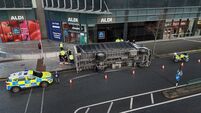Why we should be concerned about domestic drones

LET’S imagine the worst-case scenario involving domestic drones. No, not the tiny quadcopter whose operator mistakenly crashed it on the south lawn of the White House. Let’s try something scarier.
Take several drones, and equip each with a few pounds of explosives, shrapnel, and ball bearings. Then send them on a one-way kamikaze mission. As the technology advances, network the drones so they travel in a group and explode at the same time. How do you stop them?
It might sound farfetched, but scenarios like this are worrying governments across the globe. A drone attack by terrorists hasn’t happened yet. But it’s possible. German police arrested several far-right extremists who allegedly planned attacks with a drone in 2013.
Like the car bomb, the drone bomb could become a cheap, ubiquitous and anonymous way to deliver explosives. The machines can hop fences, bypass checkpoints and move too fast for a security team. What if the target is a politician, general, or a president?
The good news is drones are easily jammed. Almost all rely on a radio link to a ground controller, which makes them vulnerable to electronic interference. With an accurate enough sensor, anyone can search and pinpoint drones nearby, tune their jammer to the same frequency and overwhelm the vehicle with electronic “noise”.
Most domestic drones are highly vulnerable to this attack. Most consumer drones available in a hobby shop usually communicate using a 2.4 or 5.8 gigahertz frequency, or some combination if they carry wireless video cameras. Two devices using the same frequency can conflict with each other, which makes flying drones in urban areas risky. Wireless internet routers inside mobile phones and laptops often broadcast using the same frequencies.
Most drone software is also rarely encrypted. For years, even the military’s most advanced surveillance drones suffered from this vulnerability, which the Taliban used to intercept Predator drone surveillance videos over Afghanistan. In 2011, Iran used a more sophisticated form of GPS “spoofing” to capture a secretive RQ-170 drone operated by the CIA.
The US public largely hates domestic use of drones, and only 3% are “very likely” to buy one this year, according to a recent Reuters American Insights poll.
But in a crowded area like a city or airport, searching and blocking — or hijacking — drones comes with its own set of problems. Complex sensor and jamming devices are very expensive. A Homeland Security sensor deployed to spot, but not interfere with, drones flying above the Major League Baseball All-Star Game in Minneapolis last July “cost several hundred thousand dollars to operate for just that night”, reported the New York Times.
The US Secret Service uses covert radio-frequency jammers inside a Chevrolet car that travels with the president’s motorcade. These devices disable remotely triggered improvised bombs. But as they have to disable explosives set off by a potentially large number of frequencies, the jammers saturate a wide spectrum, occasionally interfering with mobiles nearby.
This is just a temporary inconvenience for anyone standing near the convoy. If you think that’s bad, a permanent electromagnetic shield around the White House would interfere with the whole neighbourhood. It goes without saying that shooting a civilian drone out of the sky poses a whole other set of complications. But it has happened.
In December 2013, the crew of a Chinese military helicopter shot down a fixed-wing drone, which looks like a tiny aeroplane, with an 8.5ft wingspan, as it neared Beijing Capital Airport. The drone delayed several flights. According to the People’s Liberation Army Daily, police arrested three employees of the private drone company Beijing UAV Sci-Tech and charged them with endangering public security.
After the drone incident at the White House, Representative Elijah Cummings (Democrat, Maryland) called for building a defence system akin to Israel’s Iron Dome. That uses guided missiles to intercept rockets.
“Just like our friends in Israel feel comfortable with that Iron Dome, I want the people in the White House to feel comfortable, too, and I want the people who are trying to do us harm to know they cannot penetrate that sky over the White House,” Cummings told the Washington Post.
But Iron Dome has a somewhat mixed success record, at best. Even if the interceptors hit a rocket, the incoming warheads, in many cases, continue tumbling down toward populated areas. The same is true for a drone. Then you have to worry about accidentally shooting whatever is behind it. It could be a tourist or a commercial airliner.
Instead of a one-size-fits-all solution, it’s better to have a mix of systems. For the recreational pilot who loses control of his machine, better firmware can keep it from hovering over prohibited areas. Sense-and-avoid radars can tell pilots what to avoid. None of this will stop a dedicated bad guy, but it’s enough to cut down on errant robots flying off course.
Let’s leave the jamming for the worst-case scenarios.















